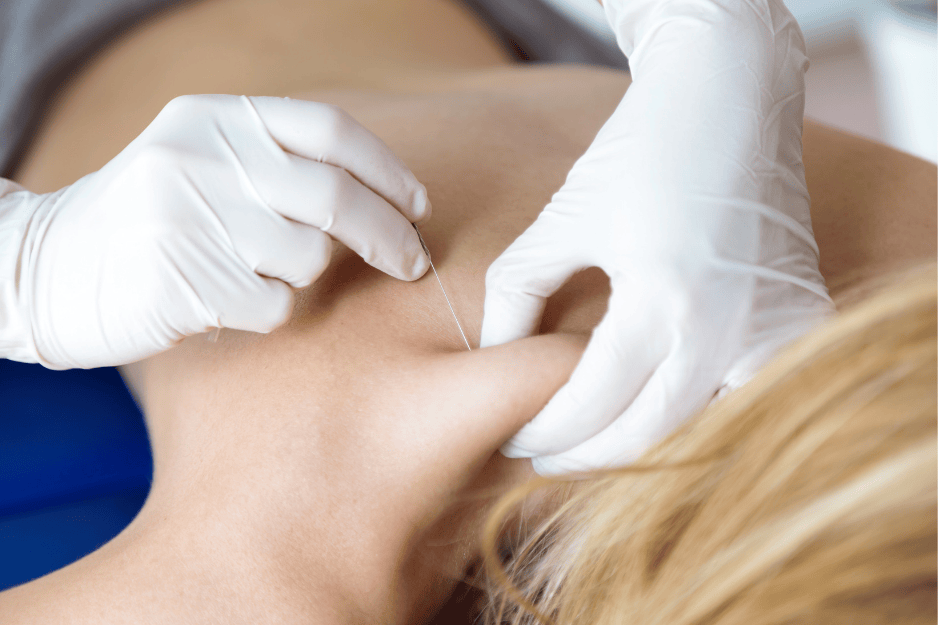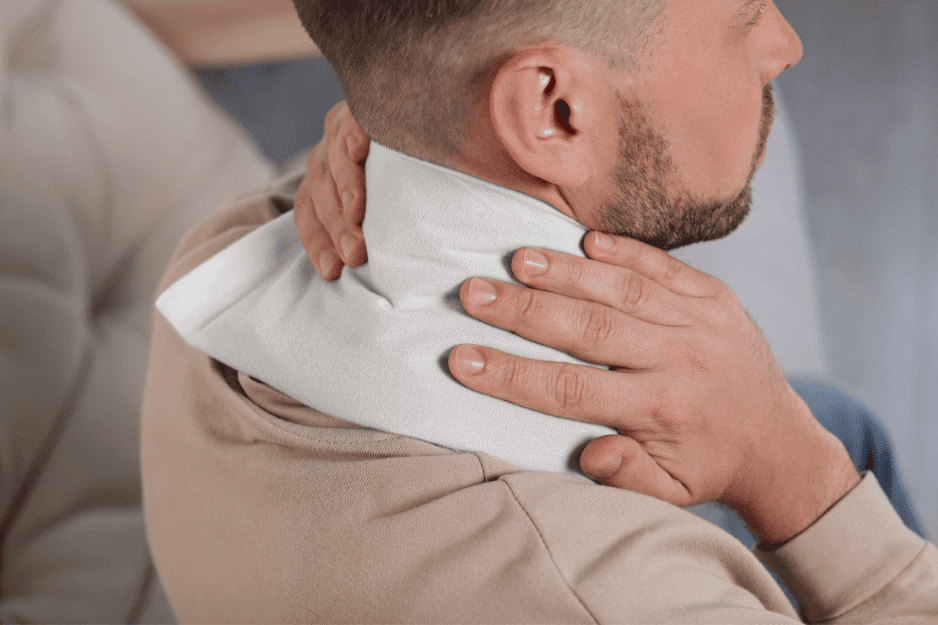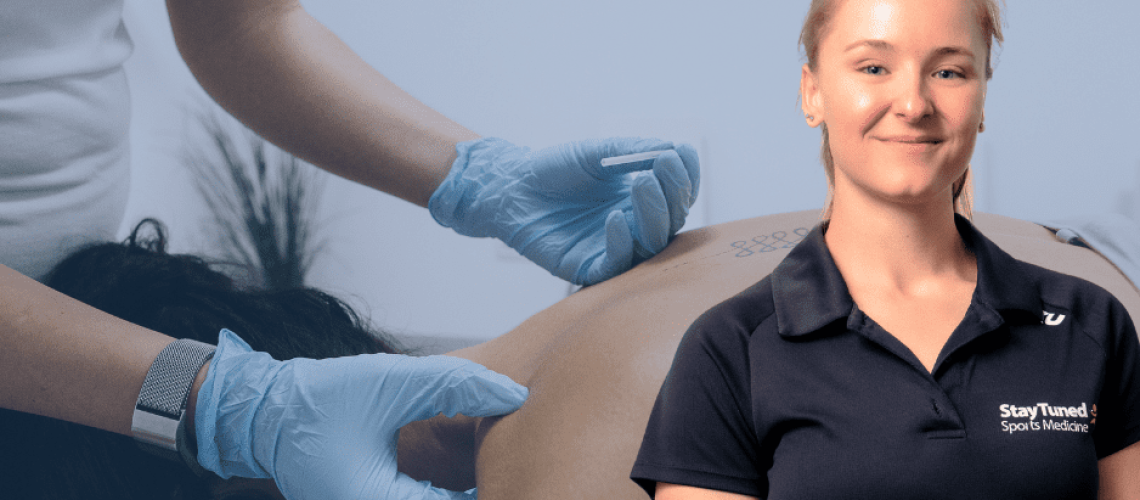Dry needling, also known as intramuscular stimulation, is a therapeutic technique rooted in Western medicine. It targets specific anatomical structures, primarily myofascial trigger points—tight, knotted areas within muscle fibers that can cause pain and dysfunction (Cagnie et al., 2013). Dry needling is distinct from acupuncture, which follows traditional Chinese medicine principles and focuses on balancing energy flow (Qi) along meridians (Gattie et al., 2017).
At Stay Tuned, dry needling is one of many skills our osteopaths, physiotherapists and myotherapists use to address pain, tension, and restricted mobility. It’s a powerful, evidence-based approach that complements manual therapy and exercise programs to help patients achieve lasting relief.
Table of Contents
How does dry needling work?
When muscles are overused, they can enter a state known as an energy crisis, where the muscle fibers do not receive an adequate blood supply. Without sufficient oxygen and nutrients, these muscles cannot return to their normal resting state, leading to tension and discomfort.
As a result, the tissue around the trigger point becomes more acidic, sensitising nearby nerves and causing soreness and pain. Dry needling involves the use of a fine needle to stimulate the trigger point, which helps restore normal blood flow to the area and flush out accumulated acidic byproducts.
This increased circulation delivers oxygen and nutrients to the affected muscle, facilitating its relaxation. Additionally, the needle’s insertion can activate nerve fibers, prompting the brain to release endorphins—the body’s natural painkillers—further alleviating discomfort.

Several physiological mechanisms contribute to the effectiveness:
- Neurophysiological Effects: It stimulates both local and central nervous system responses, reducing pain perception and promoting muscle relaxation (Kietrys et al., 2013).
- Local Twitch Response: The needle may induce a brief, involuntary muscle contraction, helping reset muscle tone and reduce tightness.
- Improved Blood Circulation: Needling increases local blood flow, promoting oxygen and nutrient delivery to aid in tissue repair.

Why Choose Dry Needling?
Many individuals experience chronic pain or limited mobility due to muscle tightness, trigger points, or tension that conventional therapies like massage or stretching may not fully resolve. Dry needling provides an effective alternative by:
- Targets Trigger Points: Helping “reset” muscle fibers and reduce tension in the treated muscle and surrounding tissues.
- Immediate Pain Relief: Reduces sensitivity at the trigger points, providing immediate pain relief.
- Relieving Referred Pain Patterns: Such as a tight shoulder causing headaches.
- Restoring Muscle Function: Relaxes hypertonic muscles, improving movement, flexibility, and strength.
- Increased Blood Flow: Enhances circulation, bringing oxygen and nutrients to muscles for faster healing.
- Reduced Muscle Spasms: Eases muscle spasms and tension in the treated muscle and surrounding tissues.

What to Expect
- Initial Assessment: Your practitioner will assess your pain and muscles and identify areas with trigger points or restricted movement. At Stay Tuned, our practitioners will only utilise dry needles when it is clinically indicated.
- Consent and Explanation: The procedure, benefits, and potential side effects will be explained, and your consent will be obtained.
- Application of Needles:
- Fine, sterile needles are inserted into the identified trigger points.
- You may feel a slight pinch or pressure as the needle is inserted.
- A local twitch response or dull ache is typical as the muscle releases.
- Sensation During Treatment:
- Mild discomfort, heaviness, or warmth in the treated area is typical, but these sensations are typically brief and manageable.
- The treatment is generally quick, lasting a few minutes per trigger point.
- Due to the fine diameter of the needles, it is also often less painful than traditional deep-tissue massage.
Post-Treatment Sensations
Patients often experience varying degrees of soreness, similar to post-exercise fatigue. Common sensations include:
- Soreness or aching for 1–3 days post-treatment.
- A feeling of lightness or looseness in the treated area.
- Improved mobility and reduced pain sensitivity immediately or shortly after treatment.
To alleviate any post-treatment discomfort, we recommend:
- Applying a heat pack to the area.
- Gentle stretching to promote mobility.
- Staying hydrated to support recovery.

Conditions Commonly Treated
Dry needling is highly effective for a wide range of musculoskeletal issues, including:
- Chronic muscle pain and tightness
- Repetitive strain injuries (e.g., tennis elbow, carpal tunnel)
- Postural imbalances due to prolonged sitting or poor ergonomics
- Sports injuries such as muscle strains or tendinopathies
- Headaches and migraines related to neck tension
- Lower back pain and sciatica caused by muscular dysfunction
Dry needling is a powerful tool for managing pain, enhancing mobility, and restoring muscle function. It complements other manual therapy treatments to provide a holistic approach to healing. Our Allied Health Practitioners at Stay Tuned are here to help you move better and feel your best; click here to make a booking.
Dr Amy Welsh
Osteopath

If you’re curious whether dry needling is right for you, call us at 9531 0909 today or explore more through these resources:
References
Cagnie, B., Dewitte, V., Barbe, T., Timmermans, F., Delrue, N., & Meeus, M. (2013). Physiologic effects of dry needling. Current Pain and Headache Reports, 17(8), 348. https://doi.org/10.1007/s11916-013-0348-5
Dommerholt, J., Fernández-de-las-Peñas, C., & Gerwin, R. D. (2018). Trigger point dry needling: An evidence and clinical-based approach. Elsevier Health Sciences.
Gattie, E., Cleland, J. A., & Snodgrass, S. (2017). Dry needling for musculoskeletal pain: A clinical commentary. International Journal of Sports Physical Therapy, 12(4), 860–866.
Kietrys, D. M., Palombaro, K. M., & Azzaretto, E. (2013). Effectiveness of dry needling for upper-quarter myofascial pain: A systematic review and meta-analysis. Journal of Orthopaedic & Sports Physical Therapy, 43(9), 620–634. https://doi.org/10.2519/jospt.2013.4668

